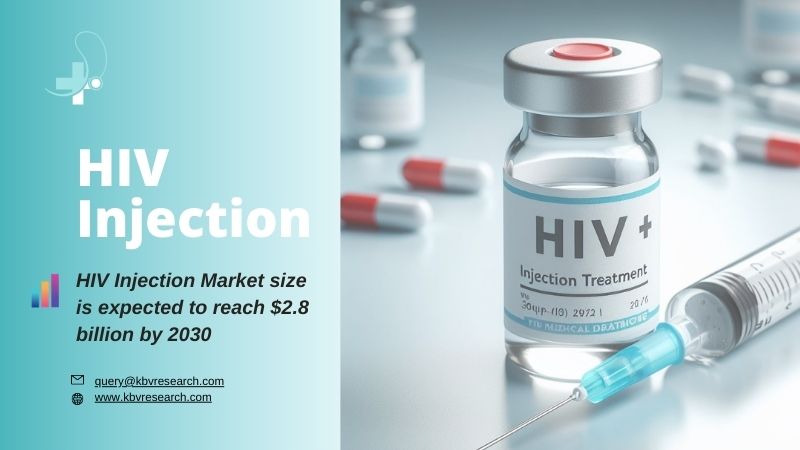
Did you know that the global HIV injection market is projected to soar to an astounding $2.8 billion by 2030? That's a staggering growth rate of 17.6% CAGR over the forecast period. This unprecedented surge is reshaping the landscape of HIV treatment, offering hope and opportunity for millions worldwide.
Numerous factors impact the dynamics of the HIV therapy market, encompassing both discoveries and persistent challenges. Let's explore the factors that propel the industry forward and those that create obstacles in its path.
The relentless march of technology has revolutionized HIV treatment, ushering in a new era of innovation and discovery. From novel drug delivery systems to cutting-edge diagnostic tools, technological advancements are expanding the horizons of possibility, offering hope for improved patient outcomes.
Increased awareness and advocacy efforts have played a pivotal role in driving demand for HIV treatment and care. Through education and outreach initiatives, communities are empowered to seek the resources and support they need, reducing stigma and promoting access to essential services.
Pharmaceutical companies continue to invest heavily in research and development, striving to bring new and improved HIV therapies to market. Focusing on efficacy, safety, and patient convenience, these innovative treatments are driving growth in the HIV injection market and providing healthcare providers with powerful tools to combat the disease.
Despite significant progress, access to HIV treatment remains a challenge for many individuals, particularly in low- and middle-income countries. Economic barriers, logistical challenges, and regulatory hurdles can impede access to essential medications, preventing patients from receiving the care they need to manage their condition effectively.
Stigma and discrimination continue to cast a shadow over the HIV/AIDS epidemic, deterring individuals from seeking testing, treatment, and support services. Addressing stigma requires a multi-faceted approach, encompassing education, advocacy, and community engagement to challenge misconceptions and promote acceptance and understanding.
Weak healthcare infrastructure poses a significant barrier to effective HIV treatment and care in many regions of the world. Limited access to healthcare facilities, shortages of trained personnel, and inadequate supply chains can hinder the delivery of essential services, undermining efforts to control the spread of the disease and improve patient outcomes.
As we navigate the complex terrain of the HIV injection market, several trends emerge as key drivers of growth. From advances in drug delivery systems to the emergence of novel therapeutic approaches, innovation is reshaping the treatment landscape.
One notable trend is the growing emphasis on long-acting injectables, which offer the convenience of fewer doses and improved adherence. This shift towards sustained-release formulations represents a paradigm shift in HIV treatment, empowering patients with greater flexibility and control over their healthcare journey.
Moreover, the rise of personalized medicine is poised to revolutionize HIV treatment, enabling tailored therapies that address the unique needs of individual patients. Healthcare providers can optimize treatment strategies and improve patient outcomes by harnessing the power of genomics and biomarkers.
Despite remarkable progress, the fight against HIV/AIDS is not without its challenges. Stigma and discrimination continue to pose significant barriers to care, preventing many individuals from accessing the treatment and support they desperately need.
Moreover, disparities in healthcare access and resources persist, exacerbating existing inequalities in HIV care. From marginalized communities to underserved regions, addressing these disparities is essential to achieving equitable outcomes for all individuals affected by HIV/AIDS.
As we stand on the cusp of a new era in HIV treatment, the need for collaboration and innovation has never been greater. By harnessing the power of research, technology, and community engagement, we can overcome the barriers to progress.
Together, we have the opportunity to redefine the future of HIV treatment, offering hope and healing to millions around the globe. With determination and resolve, we can turn the tide against HIV/AIDS, ushering in a world where every individual has access to the care they need to thrive.
In conclusion, several factors that promise to change the therapeutic landscape combine to propel the worldwide HIV injection market toward unprecedented growth. Gaining insight into the complexities of this changing environment, ranging from market dynamics to emerging trends, is essential to seizing new opportunities and promoting constructive change.
As we look ahead, let us reaffirm our commitment to advancing HIV treatment and care, ensuring that no one is left behind in the fight against this devastating disease. Together, we can build a future where HIV/AIDS is no longer a barrier to health and well-being but a chapter in the history of humanity's triumph over adversity.